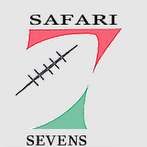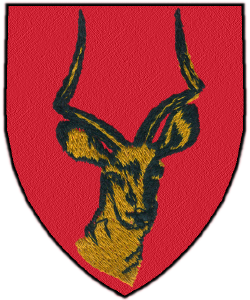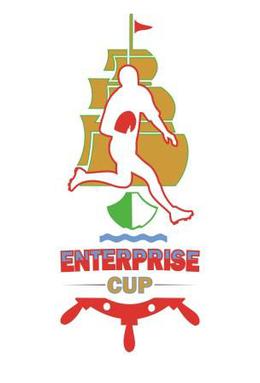
Twickenham Stoop Stadium is a sports stadium located in south-west London, England. The stadium is home to Harlequins rugby union team, who play in the Gallagher Premiership. The stadium has a capacity of 14,800 and is situated just across the road from Twickenham Stadium.

Kenya Rugby Union (KRU) is the governing body for rugby union in Kenya. It was founded in 1970 and is affiliated to Rugby Africa and the international governing body World Rugby.

The Safari Sevens is an annual rugby sevens tournament held in Nairobi, Kenya. The Safari Sevens is open to international representative sides, professional and amateur clubs, invitational teams, university and school teams.

The Kenya national rugby union team, commonly known as the Simbas, is the country's national team managed by the Kenya Rugby Union. The team plays in red, green, and black jerseys with black or white shorts. The Simbas represent Kenya in the Africa Cup and various other tournaments across the continent. They currently rank 34 in the World Rugby Rankings and fourth in Africa. Kenya is yet to qualify for the Rugby World Cup.

Rugby union in Kenya is a popular sport, in particular due to the success of the Kenya national rugby sevens team in the rugby sevens format, and tournaments such as the Safari Sevens, which has been growing yearly, and now includes numerous international teams.

The Elgon Cup is contested between the rugby union teams of Kenya and Uganda. The men's and women's teams of these countries each compete annually for their respective cups on a Home-and-Away basis. The competition and the cups are named after Mount Elgon, a mountain on the border of the two countries.
In 1955 the British Lions rugby union team toured Southern and Eastern Africa. The Lions drew the test series against South Africa, each team winning two of the four matches. They won the first test by a single point and the third by three points and lost the second and fourth matches by wider margins. As well as South Africa, the tour included a match against South West Africa, two games against Rhodesia and one versus East Africa.
Rugby union in Tanzania is a minor but growing sport.

Established in 1950, the East Africa rugby union team is a multi-national rugby union team drawing players from Kenya, Uganda and Tanzania, though the vast majority of these came from Kenya which has traditionally been the strongest rugby playing nation in the region. The team has played against incoming international, representative and club touring sides and it conducted seven tours between 1954 and 1982.

Impala Saracens is a Kenyan rugby club based at the Impala Club. The club competes in the Kenya Cup as well as the Enterprise Cup. The club is based and trains at their ground on Ngong Road, adjacent to the RFUEA Ground, and also has an association football division.

Kenya Harlequin Football Club, is a Kenyan rugby union club that competes in the Kenya Cup, the top level of Kenyan rugby. The club motto "Nunquam Dormio" is Latin, meaning I never sleep.

The Rugby Football Union of East Africa (RFUEA) is an umbrella union for the Kenya Rugby Football Union, Tanzania Rugby Football Union and Uganda Rugby Football Union. It owes its existence to the fact that, prior to independence, Kenya, Tanzania and Uganda were either a protectorate or mandate of the British Empire. It now has little to do with the direct administration of the modern game but it continues to exist in order to promote and support the game in the three countries, to facilitate club competition between the three unions and to administer the RFUEA Ground and the East Africa rugby union team.

The Bamburi Super Series was an East African Rugby union competition with eight teams in total, five teams from Kenya two from Uganda and one from Tanzania (Twigas) that is currently defunct. It is closely based on the Super Rugby competition in the southern hemisphere. Games take place at the RFUEA Ground in Nairobi (Kenya), Friedkin Recreation Centre in Arusha (Tanzania) and the Kyadondo Grounds, Kampala (Uganda). Rhinos have won the most titles with four wins, and are the only team to have defended a title when they beat the Cheetahs 25–5 in the 2010 final.
Maurice John P. Daly was an English player of rugby union football, who played internationally for both Ireland and East Africa. Along with W.B. Young of Scotland he is one of only two people to have been capped by a major rugby playing nation and by East Africa.
KCB Rugby Club is a rugby union team based in Nairobi, Kenya. It was formed in 1989 after the disbanding of Kenya Breweries RFC when their main sponsor, Kenya Breweries, pulled out. That year they joined the Kenya Cup. Their first match was against Impala RFC, whom they beat 96–6. In 1994 the team was relegated to the Eric Shirley Shield, however by 1996 they had regained their position in Kenya's top rugby league. The club now has a 2nd XV team which has performed well, winning the Mwamba Cup, and Eric Shirley Shield several times.

The Enterprise Cup is an annual rugby union competition in Kenya, Tanzania and Uganda, though the competition frequently has the appearance of being an all-Kenyan affair as the majority of rugby clubs in the African Great Lakes region are based in this one country and frequently clubs in Tanzania and Uganda are unable to take part due to financial constraints. The original cup was donated by sailors from HMS Enterprise, who had toured British East Africa in 1928. The only years in which the competition has not been played is between 1940–1946 due to World War II and in 1987 because an international rugby competition was held on RFUEA Ground as part of the All Africa Games.
Rugby union in East Africa is almost entirely an amateur sport. It has been played in the three East African nations for more than a century; the first recorded match taking place in 1909, though it was almost certainly being played for several years prior to this. There are many club and school teams, the oldest of which were established in Colonial times.

The Scorpions RFC is an invitation rugby team in East Africa that was established upon principles that have many parallels with the Barbarian F.C. in terms of values, playing style, selection policy and the lack of a home ground. The team wears black shirts and white shorts and, like the original Barbarians and the French Barbarians, players wear socks of their choice provided that they have played for the team that the socks represent.
The 2011 Safari Sevens were the 16th annual edition of the Safari Sevens.

Kisumu Rugby Football Club is a Kenyan rugby union club based in Kisumu. Also known as Lakeside RFC, for the 2015–16 season the club competes in the Nationwide League.















